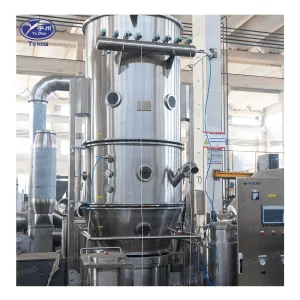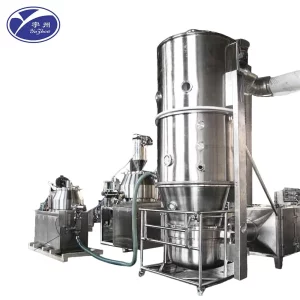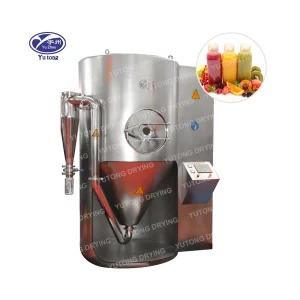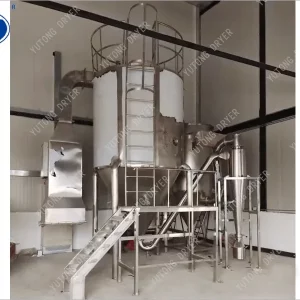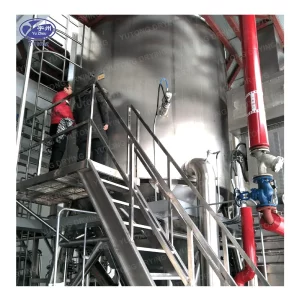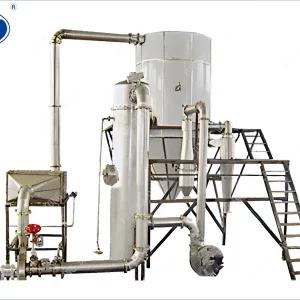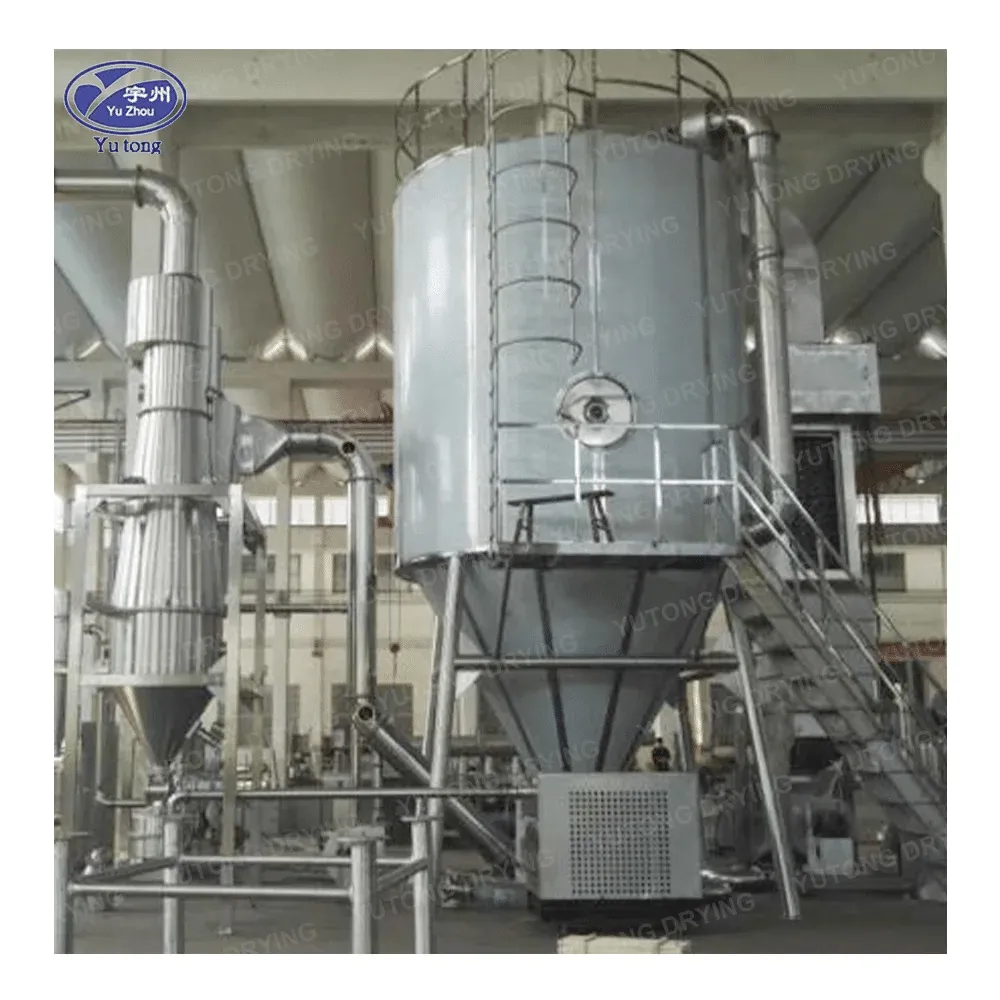Fluidized bed drying is a process where solid particles are suspended in an upward-flowing stream of air or gas. This suspension creates a fluid-like state, allowing for even and efficient drying.
The Science Behind Fluidization
Fluidization is a process that occurs when a fluid, typically air, flows upward through a layer of solid particles with enough velocity to suspend them. This creates a dynamic environment where the solid particles behave like a fluid, allowing for greater interaction with the drying medium. The principle of fluidization is based on balancing the gravitational forces of the particles with the drag forces exerted by the fluid. This balance ensures that each particle is thoroughly exposed to the drying air, which optimizes moisture removal.
Components of a Fluidized Bed Dryer
A fluidized bed dryer consists of several critical components that facilitate the drying process. These include the drying chamber, air distribution system, heating element, and exhaust system. The drying chamber is where the food product is placed, and it is designed to promote uniform airflow. The air distribution system ensures even air movement across the chamber. The heating element provides the necessary thermal energy to convert moisture into vapor, while the exhaust system removes the moisture-laden air from the chamber.
Key Parameters for Effective Drying
Several parameters influence the effectiveness of fluidized bed drying. These include airflow rate, temperature, particle size, and bed height. The airflow rate must be optimized to achieve proper suspension without causing particle attrition. Temperature control is crucial to prevent overheating and degradation of the product. Particle size affects how easily particles can be fluidized; smaller particles require less air velocity. Lastly, bed height impacts the residence time of particles in the drying chamber, influencing the drying efficiency.
Advantages of Fluidized Bed Drying
Fluidized bed drying offers several advantages over traditional drying methods.
Superior Efficiency
Fluidized bed drying is known for its high efficiency. The process ensures uniform drying, reducing the chances of uneven moisture content in the final product. This uniformity is crucial for maintaining product quality and shelf life. The even distribution of heat and airflow in a fluidized bed dryer means that all particles achieve the desired moisture content simultaneously, reducing the need for additional processing steps.
Energy Conservation
Compared to other drying equipment, fluidized bed dryers are energy-efficient. The process requires less energy because the drying air is recirculated, which minimizes energy wastage. The recirculation of air not only conserves energy but also reduces operational costs. By optimizing energy use, fluidized bed dryers contribute to a more sustainable and cost-effective production process, making them an attractive option for eco-conscious manufacturers.
Versatile Applications
This method is versatile and can be used for a wide range of food products. Whether you’re processing grains, spices, or even certain snacks, fluidized bed drying can handle it all. Its adaptability extends to various industries beyond food processing, including pharmaceuticals and chemicals. The ability to process diverse materials without significant modifications to the equipment underscores the flexibility of fluidized bed drying systems.
Enhanced Product Quality
By ensuring even drying, fluidized bed drying helps maintain the nutritional content and flavor of the food. This is especially important in the food industry, where product quality is paramount. The gentle drying process preserves the structural integrity of food particles, preventing damage that could alter taste or texture. As a result, products retain their desirable sensory attributes, which is crucial for consumer satisfaction and brand reputation.
Fluidized Bed Drying vs. Other Industrial Drying Solutions
When comparing fluidized bed drying to other industrial drying solutions, several factors come into play.
Drum Drying: A Comparative Analysis
Drum drying involves spreading the product over a rotating drum, which is heated from the inside. While effective for certain applications, drum drying can lead to uneven drying and potential flavor loss. The contact with the heated drum surface can cause caramelization or burning of sugars, negatively impacting flavor and color. In contrast, fluidized bed drying offers more consistent results, as the entire product is exposed to the drying air simultaneously, ensuring even moisture removal.
Spray Drying: Efficiency and Limitations
Spray drying is another popular method, particularly for liquid products. It involves spraying the product into a hot air chamber, where it dries into a powder. While efficient, spray drying can be more costly and is not suitable for all food products. The high temperatures required can degrade sensitive ingredients, such as vitamins and flavors. Fluidized bed drying, on the other hand, is more versatile and can handle a broader range of food items, including those with delicate compositions.
Freeze Drying: Preservation vs. Cost
Freeze drying is a process where the product is frozen and then subjected to a vacuum, causing the moisture to sublimate. While freeze-drying is excellent for preserving flavor and nutrients, it is often more expensive and time-consuming. The lengthy processing time and high energy consumption make it less feasible for large-scale operations. Fluidized bed drying provides a more cost-effective and quicker solution for many food processing needs, balancing quality preservation with operational efficiency.
Choosing the Right Drying Equipment
Selecting the right drying equipment is crucial for any food processing business. Consider the following factors:
Assessing Product Characteristics
The type of product you’re processing will largely determine the best drying method. For granular and particulate foods, fluidized bed drying is often the optimal choice. Understanding the moisture content, particle size, and thermal sensitivity of your product is essential for selecting the appropriate drying technology. Each product has unique characteristics that influence how it interacts with drying processes, necessitating tailored solutions.
Evaluating Cost Implications
Budget constraints can influence the choice of drying equipment. While fluidized bed dryers may have a higher upfront cost, their efficiency and energy savings can lead to long-term cost reductions. Analyzing the total cost of ownership, including maintenance and energy consumption, provides a clearer picture of the financial benefits over time. Investing in efficient equipment can result in significant savings, offsetting initial expenses and enhancing profitability.
Determining Production Scale
For large-scale operations, the efficiency and speed of fluidized bed drying can make a significant difference in production timelines and output quality. The scalability of fluidized bed dryers allows them to accommodate varying production demands, from small batches to continuous high-volume processing. This adaptability ensures that production targets are met without compromising quality or incurring excessive costs.
Meeting Quality Standards
If maintaining the highest quality in terms of flavor and nutritional content is a priority, fluidized bed drying is an excellent option. Ensuring compliance with industry standards and consumer expectations is crucial for brand success. Fluidized bed dryers provide the precision and control needed to achieve consistent quality, thereby enhancing consumer trust and satisfaction.
Implementing Fluidized Bed Drying in Your Process
Integrating fluidized bed drying into your food processing line involves several steps:
Conducting a Needs Assessment
Determine the specific requirements of your production process. This includes the type of food products, desired moisture content, and production capacity. A comprehensive needs assessment ensures that the drying solution aligns with operational goals and product specifications. Identifying key performance indicators (KPIs) for drying efficiency and product quality helps guide the selection process.
Selecting Appropriate Equipment
Select a fluidized bed dryer that meets your production needs. Consider factors like size, energy efficiency, and ease of operation. Equipment selection should be based on a thorough evaluation of technical specifications and the manufacturer’s reputation. Consulting with industry experts or equipment suppliers can provide valuable insights and recommendations tailored to your unique requirements.
Training and Development
Ensure that your staff is well-trained in operating and maintaining the drying equipment. Proper training can prevent downtime and ensure the smooth running of your production line. Investing in employee development not only enhances operational efficiency but also fosters a culture of continuous improvement. Training programs should cover equipment operation, routine maintenance, and troubleshooting to equip staff with the skills needed to manage the drying process effectively.
Continuous Monitoring and Optimization
Once implemented, continually monitor the drying process to identify areas for improvement. Regular maintenance and optimization can help maximize the efficiency and lifespan of your equipment. Establishing a robust monitoring system allows for real-time tracking of drying parameters and early detection of potential issues. Implementing a proactive maintenance schedule reduces the risk of unexpected breakdowns, ensuring consistent production quality.
Conclusion
Fluidized bed drying is a powerful tool in the arsenal of food processing technologies. Its efficiency, versatility, and quality assurance make it a preferred choice for many in the industry. By understanding its benefits and implementation strategies, businesses can significantly enhance their production processes and deliver high-quality products to consumers. As the food industry continues to evolve, staying informed about the latest industrial drying solutions will ensure that your business remains competitive and innovative. Embracing advancements in drying technology not only enhances operational efficiency but also aligns with sustainability goals, positioning your business for long-term success in a dynamic market landscape.

